V Arithmetic operation
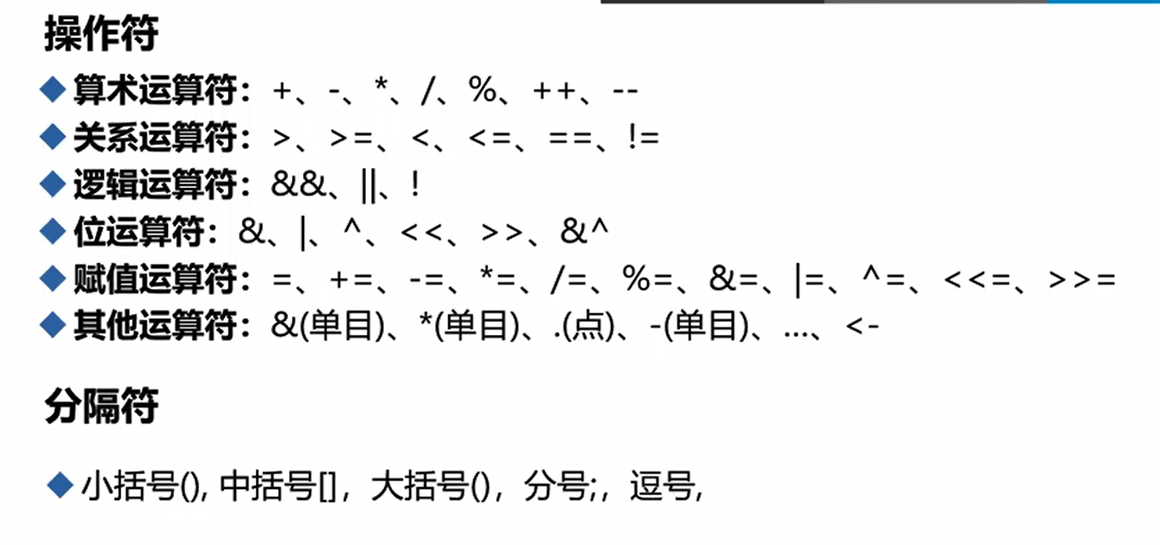
Logic and
0 && 0 =1 1 && 1 =1 1 && 0 =0
Logical or
0 || 0 =0 0 || 1 =1 1 || 0 =1 1 || 1 =1
Relational operation: the result is also true and false
Arithmetic operator
+ ,- ,* ,/ ,%
Self increment: + +, which can only be used for variables and can only be placed later
Self subtraction: –
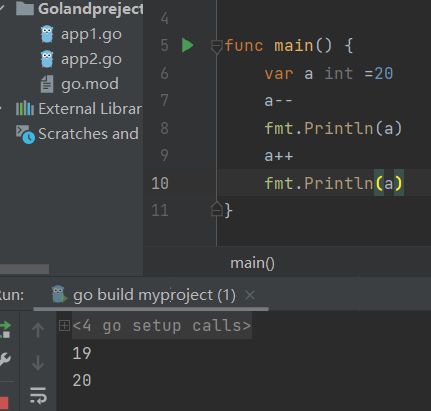
Assignment operation
== ,!= ,> , >= , < ,<=
The result is a Boolean bool
Bit operation
That is, binary operation
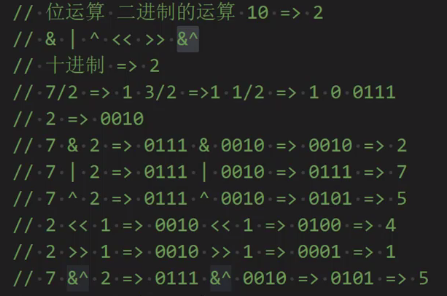
&And operation, the same is 1, the difference is 0
|Or operation, with 1, is 1
^And or, the difference is 1
&^Clear by bit, and clear the positions that are all 1
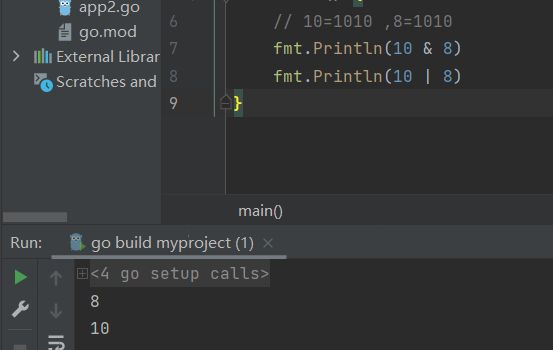
Move left < <, into 2
Move right > >, divide by 2
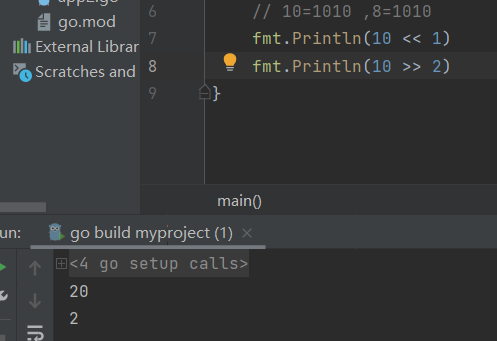
Assignment operation
= , +=, -=, *=, /= , %=, ,|= ,&= ,^= , &^= , <<= , <<=
Type conversion
- Different types cannot operate without any operation
- From large to small, overflow may occur
Cast type
var A int =3 var B uint =4 fmt.Println(A+ int(B))
Vi Process control
1 . Conditional statement if else
&&Both sides should be satisfied
||There is a satisfaction
if condition {
} else if condition{
} else{
}
var yes string
fmt.Scan(&yes)
if yes == "Y" || yes == "y"{
fmt.Println("ok")
} else{
fmt.Println("error")
}
2 . Select the statement switch
There are two main uses
- Single value, matching variables
- Expressions for comparison
- case can be followed by multiple conditions
- Penetrate the fallthrough. Adding the fallthrough after the case statement block will continue to execute the next case
switch variable {
# Value, which can be multiple
case value :
Statement 1
case value ;
Statement 2
default:
Statement 3
}
Single value, matching
var yes string
fmt.Scan(&yes)
switch yes {
case "y","Y":
fmt.Println("ok")
default:
fmt.Println("no")
}
Expressions for comparison
switch{
case A>=90:
fmt.Println("A")
case A>=80:
fmt.Println("A")
}
Match type
var x interface{} //x is an empty interface type and can receive any type
var y = 19.9
x = y
switch i := x.(type) {
case nil:
fmt.Printf("x The type of is%T\n", i)
case float64:
fmt.Printf("x The type of is%T\n", i)
default:
fmt.Println("unknown type")
}
Switchable function
switch can be followed by a function, as long as the value type after case is consistent with the return value of the function.
import "fmt"
// A function to judge whether a student has failed in the course
// The return value is Boolean
func getResult(args ...int) bool {
for _, i := range args {
if i < 60 {
return false
}
}
return true
}
func main() {
chinese := 80
english := 50
math := 100
switch getResult(chinese, english, math) {
// case must also be Boolean
case true:
fmt.Println("The student passed all his grades")
case false:
fmt.Println("The student has a failed record")
}
}
switch can not receive expression
No variables, expressions or functions can be connected after switch.
When nothing is received, switch - case is equivalent to if - else if - else
score := 30
switch {
case score >= 95 && score <= 100:
fmt.Println("excellent")
case score >= 80:
fmt.Println("good")
case score >= 60:
fmt.Println("qualified")
case score >= 0:
fmt.Println("unqualified")
default:
fmt.Println("Incorrect input...")
}
3 . Loop statement for
Mode 1
source :=0
//Post initial condition
for i:=1 ; i <=100 ; i++{
source +=i
}
fmt.Println(source)
Mode II
source =0
i :=1
for i <=100 {
source +=i
i++
}
Mode 3: dead cycle
var i int =0
for{
fmt.Println(i)
i++
}
Method 4: string, array, slice, map, pipeline
Traversing an iteratable object,
range can be followed by array, slice, string, etc
Return two values: index and data. If you can't use the index in the following code, you need to use it_ express.
name :="Handsome"
//Index i, character ch name string
for i,ch := range name{
fmt.Println(i,ch)
}
Placeholder "_"
name :="Handsome"
//Index i, character ch name string
for _,ch := range name{
fmt.Println(ch)
}
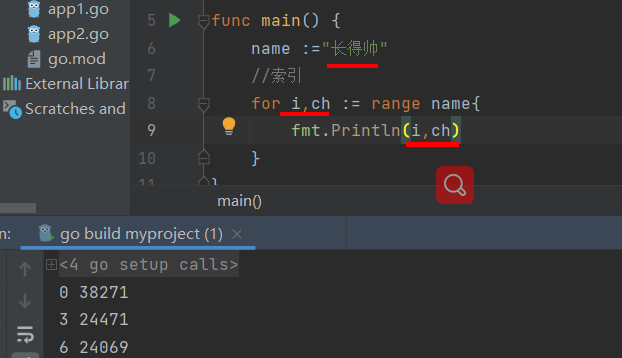
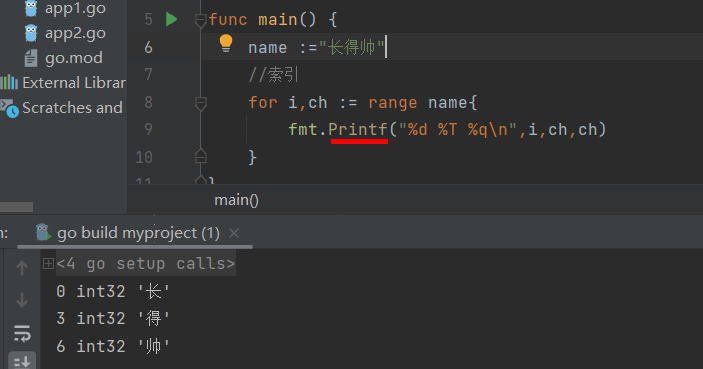
4. Closing statement
-
continue
Skip this cycle -
break
Break label jumps out of the loop. You can jump out of the multi-layer loop as follows
END
for i :=1 ;i<=100 ;i++{
break END
}
- return is used in a method or function to indicate the method or function where the termination occurs (method and function)
return in the main function, it means to terminate the main function and terminate the program
for i := 0; i <= 10; i++ {
if i == 5 {
return //Exit the main function directly
}
fmt.Printf("Number of cycles:%d\n", i)
}
//I'll never take it here. On the fifth for loop, I directly return
fmt.Println("The cycle ended and came to me")
5. Jump to goto
goto
Label: capitalized English letters, placed on the far left
You can jump out of multi-layer loops at one time
goto label A label A:
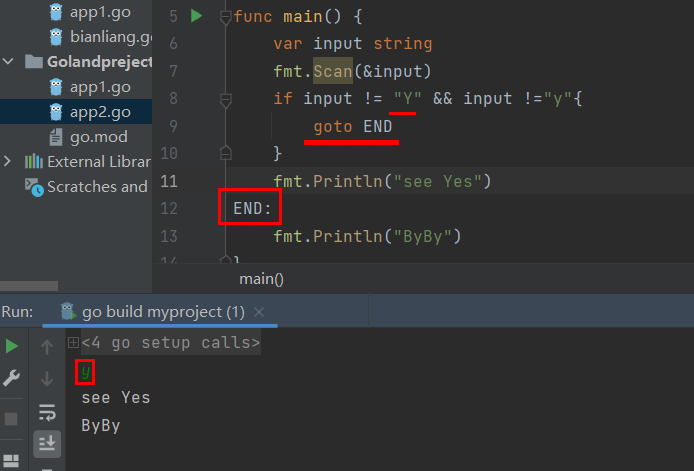
Implementing for loop with jump
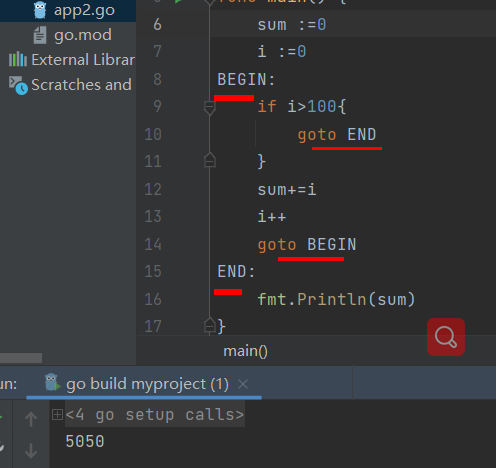
There must be no variable declaration between goto statement and label, otherwise compilation error will occur
.\main.go:7:7: goto flag jumps over declaration of say at .\main.go:8:6
6. defer deferred statement
1. Delayed call
Followed by a function call, you can delay the call of xxx function until the current function is executed.
defer xxx()
import "fmt"
func myfunc() {
fmt.Println("B")
}
func main() {
defer myfunc()
fmt.Println("A")
}
//The output is as follows
A
B
import "fmt"
func main() {
defer fmt.Println("B")
fmt.Println("A")
}
2. Snapshot of variables evaluated immediately
Using defer only delays calling the function. At this time, the variables passed to the function should not be affected by subsequent programs.
For example, here's an example
import "fmt"
func main() {
name := "go"
defer fmt.Println(name) // Output: go
name = "python"
fmt.Println(name) // Output: python
}
// output
python
go
It can be seen that when name is reassigned to python, the unassigned variable value is still used in subsequent calls to defer. Fortunately, here in defer, all this is the same as taking a snapshot.
If defer is followed by an anonymous function, the situation will be different. Defer will get the last variable value
package main
import "fmt"
func main() {
name := "go"
defer func(){
fmt.Println(name) // Output: python
}()
name = "python"
fmt.Println(name) // Output: python
}
3. Multiple defer s are called in reverse order
When we use multiple defers in a function, what are the execution functions of these defers?
import "fmt"
func main() {
name := "go"
defer fmt.Println(name) // Output: go
name = "python"
defer fmt.Println(name) // Output: python
name = "java"
fmt.Println(name) //Output: java
}
//output
java
python
go
The output is as follows. It can be seen that multiple defer s are called in reverse order, which is a bit similar to the stack. Last in first out.
4. The order of defer and return
Which of defer and return is called first?
import "fmt"
var name string = "go"
func myfunc() string {
defer func() {
name = "python"
}()
fmt.Printf("myfunc In function name: %s\n", name)
return name
}
func main() {
myname := myfunc()
fmt.Printf("main In function name: %s\n", name)
fmt.Println("main In function myname: ", myname)
}
//output
myfunc In function name: go
main In function name: python
main In function myname: go
The first line name is still a global variable, and the value is still go
The second line is not difficult to understand. When the global variable is changed in defer, the value of name has become python
In the third line, defer is called after return. Therefore, myname has been assigned to go before defer is executed.
5. Why is there a defer?
Just put the function executed by defer in return.
However, when there are multiple return s in a function, you have to call the function many times, and the code becomes bloated.
No defer
func f() {
r := getResource() //0, get resources
......
if ... {
r.release() //1. Release resources
return
}
......
if ... {
r.release() //2. Release resources
return
}
......
if ... {
r.release() //3. Release resources
return
}
......
r.release() //4. Release resources
return
}
After using defer, the code is simple and direct. No matter where you return, the function after defer will be executed.
func f() {
r := getResource() //0, get resources
defer r.release() //1. Release resources
......
if ... {
...
return
}
......
if ... {
...
return
}
......
if ... {
...
return
}
......
return
}
7. Exception mechanism: panic and recover
-
panic: throw an exception to crash the program
-
Recover: catch exceptions, recover programs or finish work
After revocer is called, the thrown panic will end here and will not be thrown out. However, recover cannot be used arbitrarily. It has mandatory requirements and must be used under defer.
1. Trigger panic
Manually triggering downtime is a very simple thing. You only need to call the built-in function panic
package main
func main() {
panic("crash")
}
After operation, the system will report errors and downtime directly
$ go run main.go
go run main.go
panic: crash
goroutine 1 [running]:
main.main()
E:/Go-Code/main.go:4 +0x40
exit status 2
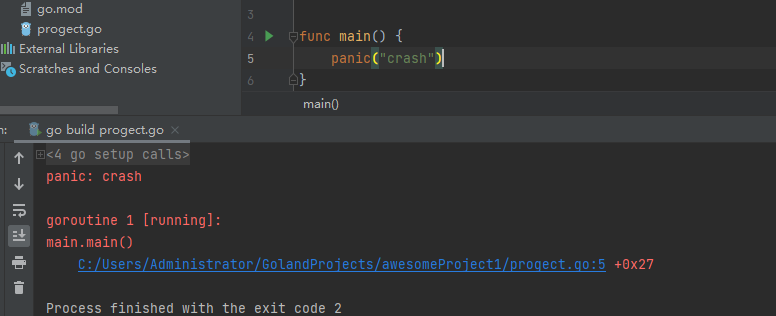
2. recover for capturing panic
When an exception occurs, you sometimes have to catch it
This leads to another built-in function - recover, which allows the program to regenerate after downtime.
However, there is a condition for the use of recover, that is, it must be in the defer function to take effect. Under other scopes, it does not work.
import "fmt"
func set_data(x int) {
defer func() {
// recover() can print the captured panic information
if err := recover(); err != nil {
fmt.Println(err)
}
}()
// Deliberately create array out of bounds and trigger panic
var arr [10]int
arr[x] = 88
}
func main() {
set_data(20)
// If this sentence can be executed, panic is captured
// Subsequent programs can continue to run
fmt.Println("everything is ok")
}
After operation
$ go run main.go runtime error: index out of range [20] with length 10 everything is ok
Generally speaking, we should not deal with the programs that enter panic downtime, but sometimes we need to recover from the downtime. At least we can do some operations before the program crashes,
When the web server encounters unexpected serious problems, all connections should be closed before the crash. If nothing is done, the client will always be waiting. If the web server is still in the development stage, the server can even feed back the exception information to the client to help debugging.
3. Unable to cross collaboration process
Even if panic will cause the whole program to exit, if there is a defer delay function before exiting, you still have to execute defer.
However, this defer has no effect among multiple coroutines. Triggering panic in a child coroutine can only trigger the defer in its own coroutine, rather than calling the defer function in the main coroutine.
import (
"fmt"
"time"
)
func main() {
// This defer does not execute
defer fmt.Println("in main")
go func() {
defer println("in goroutine")
panic("")
}()
time.Sleep(2 * time.Second)
}
//The output is as follows
in goroutine
panic:
goroutine 6 [running]:
main.main.func1()
E:/Go-Code/main.go:12 +0x7b
created by main.main
E:/Go-Code/main.go:10 +0xbc
exit status 2
practice
Output a number from bits, tens and hundreds
thinking
Hundredth: n/100%10 Ten: n/10%10 Bit: n/1%10
code
package main
import "fmt"
func main() {
var n,s int
fmt.Scan(&n)
if n>=999 {
s =4
} else if n>99{
s =3
}else if n>9{
s=2
}else {
s=1
}
for i:=1;i<=s;i++{
// l is 10 *i
l :=1
for j:=2;j<=i;j++{
l *=10
}
fmt.Println(n/l%10)
}
}
Multiple login
package main
import "fmt"
func main() {
var name,pwd string
//Limit: login can only be repeated three times,
var logincache=3
for i :=1;i<=3;i++{
fmt.Println("enter one user name")
fmt.Scanln(&name)
fmt.Println("Please input a password")
fmt.Scanln(&pwd)
if name == "qcq" && pwd == "qcq123" {
fmt.Println("Welcome to the glory of the king!")
break
}else {
logincache--
fmt.Printf("Input error, you still have%d Second chance\n",logincache)
}
}
}
Output a square line
Calculate the sum of all odd numbers within 100
func main() {
i :=1
num :=0
for i<=100{
num +=i
i+=2
}
fmt.Println(num)
}
Grade students' grades
func main() {
var n int
fmt.Scanln(&n)
switch{
case n>=90:
fmt.Println("A")
case n>=80:
fmt.Println("B")
case n>60:
fmt.Println("C")
default:
fmt.Println("You are so stupid.")
}
}
Print into a formula table
func main() {
for i :=1;i<=9;i++{
for j:=1;j<=i;j++{
fmt.Printf("%d*%d=%d\t",j,i,i*j)
}
fmt.Println()
}
}
Guess the number, generate a number, and let the user guess five times
And each time give the user a prompt, size, and several more opportunities
Re challenge